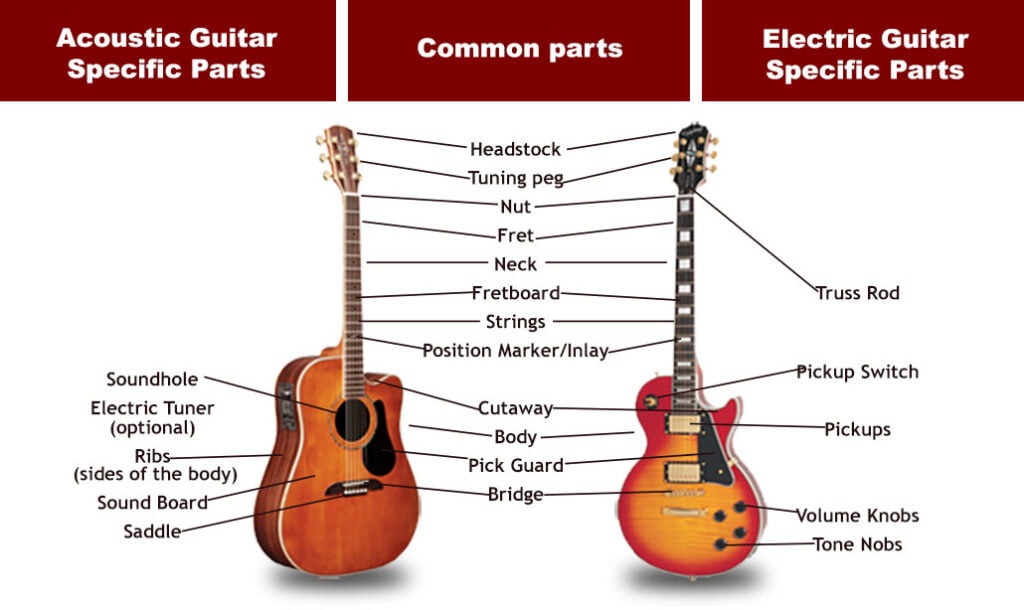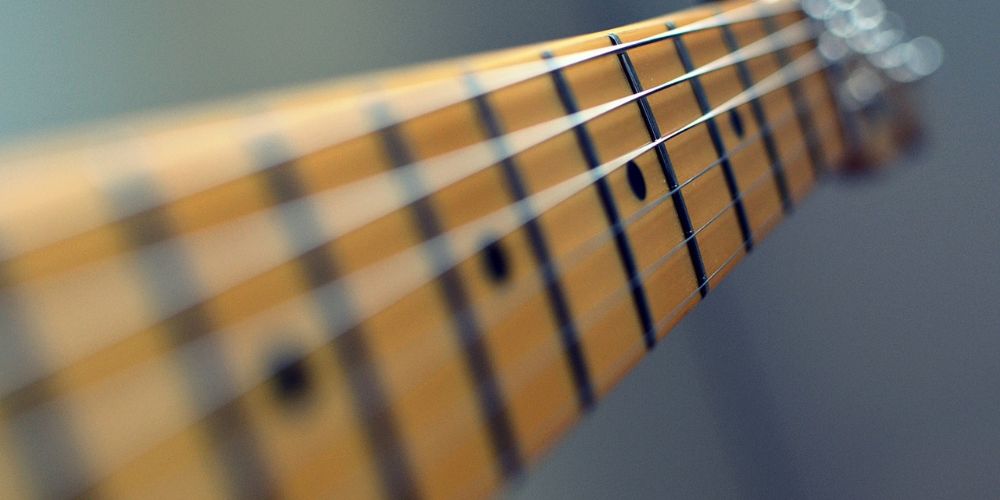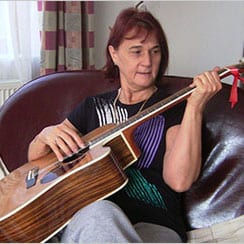Guitar anatomy isn’t a college subject 🙂 When we talk about the anatomy of the guitar, we are referring to what it's made of, how it's made, and what parts it has.
Why is it important to know the parts of the guitar? Because knowing how the guitar works can make you a better player down the line as you master your craft.
Acoustic guitar anatomy and electric guitar anatomy are similar in many ways, so we will start with a diagram of the anatomy of both the electric and acoustic guitars and explain the details afterward.

Now for the details.
The Three Main Parts of a Guitar
Every guitar, whether acoustic or electric, consists of 3 fundamental sections that work together to create music.
- The body serves as the foundation for the instrument's resonance and tone,
- the neck is the elongated piece that connects the body to the headstock and houses the fretboard,
- the headstock is located at the end of the neck where tuning occurs.

Now let's look deeper into each.
1. Body of the Guitar
The guitar body provides the resonance that shapes the tone of an acoustic or electric guitar, so it's pretty much the most important part of the guitar. It determines the volume and bass of notes when playing acoustic guitars, and the sustain of notes when playing electric guitars.
The guitar body will usually be:
- wider at the bottom (lower bout),
- thinnest in the middle,
- and a bit thicker towards the top of the guitar body (upper bout).
Several constructional aspects affect the tone given off by the body:
- Construction method: layered, one-piece, hollow, solid, etc.
- The shape and size of the body of the guitar
Tonewood Selection and Characteristics
Only high-end manufacturers use the best type of wood, but cheaper manufacturers' guitars can sound great as well. Generally, the denser, heavier the wood, the deeper, richer the sound and sustain will be.

The types of wood used for manufacturing the guitar are:
- Alder: Alder is a light, yet dense wood with a porous structure. It provides a balanced tone with a smaller upper mid-range, producing a clean sound with good resonance, providing a good dynamic range.
- Ash: Is usually used in mid priced guitars. Ash guitars are usually good quality, however, the open grain structure of the wood requires a lot of lacquer to be used, which might lower the sustain. Ash comes in 2 varieties, Northern Hard Ash (heavy and dense, nice low frequencies with long sustain), and Swamp Ash (lightweight and porous, nice balance of sound, good resonance across the entire frequency)
- Basswood: is a light wood with a consistent and tight grain pattern. It is very soft, therefore dents easily. Basswood has a warm, soft tone, with a limited dynamic range. It is not as good for playing clean notes, but playing it under distortion provides a nice metal-lead sound.
- Cedar: is one of the most used tonewoods.
- Mahogany: Is a heavy, dense wood, excellent for guitar construction. It gives off mellow, soft, yet thick tones, providing for long sustain with a nice dynamic.
- Nato: is a mahogany substitute used in budget guitars.
- Maple: usually not used for the entire guitar body, and comes in 2 varieties, Eastern Hard Maple (very hard and dense usually used to make necks, and maple syrup) and Western Soft Maple (is much lighter than its sibling, has a bright tone and is usually used as a top
- Rosewood: Is a very dense wood used to make the fretboard, the back and sides of acoustic guitars.
- Poplar: Is an interesting type of wood. Most players think of it as a budget wood, but more expensive guitars can also be found, that are made of Poplar. Its tone resembles that of Alder.
- Spruce: is one of the best tonewoods, but is unfortunately scarce and therefore expensive.
- Walnut: is harder, heavier and denser than Mahogany, providing good sustain. Tonally, it is warmer than maple, with solid low end, while the mid-range is relatively complex, and the top end is a smooth bright.
Bridge and String Attachment
The bridge is located on the guitar body and holds the strings in place. It also helps transfer string vibrations to create sound. Found on the body, the bridge anchors the strings to the guitar and transmits the string vibrations to the body.
The strings may start at the bridge or they may only be supported by it depending on the guitar. To be able to finely adjust the tone, most electric guitars allow the bridge to be raised or lowered typically by adjusting screws
Saddle
A saddle is a piece of plastic or polished bone that is used for the string to rest on, and is used on most acoustic guitars. The smoothness prevents the guitar from buzzing, and can also be used for very fine-tuning.
2. Neck Components and Construction
The long narrow part of the guitar located between the body and the headstock is the neck of the guitar.
It can be constructed of a single piece of wood, or several pieces of wood cut and glued together.

The fretboard is attached to the upper side of the neck. Most acoustic guitar necks are glued to the body (referred to as set neck), others are bolted on (usually on electric guitars). The type of neck joint can affect the instrument's sustain, tone, and overall stability.
Fretboard
Also referred to as fingerboard, the fretboard is found on the face of the neck and is constructed of hardwoods. The fretboard is usually made from hardwoods like rosewood, ebony, or maple and has metal frets embedded along its length.
Frets
Are metal wires built vertically onto the guitar neck and fretboard. The number of frets varies by guitar.
The first fret is the one nearest the nut.
Strings are pressed down behind a fret to change the note that the string will produce. Most commonly, guitars come with medium frets, where you have to press the string down to the fretboard to be able to hear a sound. Jumbo frets are, in contrast, taller, so you don't need to press down till the fretboard.
Position Markers/Inlays
Are marks on the fretboard, which allows for easy and quick mapping of the fretboard. The basic standard of position markers is one dot in the horizontal middle of the fretboard at the 3rd, 5th, 7th and 9th frets, 2 dots at the 12th fret, and on dot at the 15th, 17th, 19th, and 21st frets.
These dots can come as designer inlays for decoration, but their role is the same.
Truss Rod
Is a steel rod that runs along the neck into the body of the guitar. Steel-string acoustic and electric guitars have truss rods, since it's needed to counteract the pull of the strings on the neck, reinforcing the neck.
Truss rods also allow the curvature of the neck to be adjusted. Nylon string guitars do not require truss rods.
Nut
Is the point on the guitar neck, often referred to as fret 0, where the strings touch the neck and pass through into the tuners on the headstock. Its main function is to maintain proper string spacing.
The nut and saddle are usually made of similar material on acoustic guitars. Bone is the best material to use, but many acoustics use synthetic material nowadays.
Electric guitars commonly use plastic, synthetics, and sometimes metal nuts.
Guitar Strings and Tuning
All guitars have strings, usually six, with each string playing a different note. These guitar string names are E (6th), A (5th), D (4th), G (3rd), B (2nd), and E (1st). Some guitars, like 7-string and 12-string models, have additional strings for a richer or more versatile sound.
String gauges refer to the thickness of the strings, which affects their tension, playability, and tone.
Lighter gauge strings are easier to play but may produce less volume and sustain, while heavier gauge strings require more finger pressure but provide a fuller tone and increased volume.
Strings can be made from various materials, including steel, nickel, and cobalt, each contributing to the guitar's tonal characteristics.
3. Headstock Components
The headstock lies at the end of the guitar neck. Its major role is to support the tuners, thus is the place where the strings are tuned.
Many guitar brands have developed distinctive headstock shapes, so the headstock can be a very beautiful part of the guitar.

Tuning Pegs
The pegs are located at the headstock. Turning the tuning peg rotates gears, which tighten or loosen the winding of string, therefore increase or decrease its pitch.
With acoustic guitars, there are usually three tuning pegs on each side of the headstock — three facing down and three up when holding the guitar on your lap. (Except for Fender acoustics, which mimic Fender's electric guitar headstocks).
With electric guitars, the tuning pegs can all be on the same side of the headstock, or on both sides.
Acoustic Guitar Specific Components
There are a few parts of the acoustic guitar you won't find on an electric.
Soundhole
Only acoustic and semi-acoustic guitars have a sound hole, which amplifies the sound produced by the strings. In acoustic guitars, the body is hollow and has a soundhole that naturally makes the sound louder.
The sound waves made by the strings resonate in the body, and exit through the soundhole.
Pick Guard
Is a flat piece of plastic on the face of the guitar body. It prevents the body from being scratched by your plectrum during play.
Some elect guitars have raised pickguards, which direct your plectrum out and away from the volume and tone knobs.
Electric Guitar Electronics
The same goes for the electric guitar, the following parts you won't find on the acoustic.
Pickups
Only found on electric guitars, a pickup is actually a magnet wrapped in wires (electromagnet) on the face of an electric guitar, directly underneath the strings. The vibration of the strings interferes with the magnetic field of the pickup. This impulse is sent to the amplifier to be modified.
So the pickup, in every sense of the word, literally "picks up" the vibration of the strings. A guitar usually has between 1 and 4 pickups, 2 being the most common.
Pickups sound different depending on where they are on the body, how they are coiled, what material was used, etc.
Pickups towards the neck have a brighter tone and will express harmonics more clearly. Pickups toward the bridge sound darker and dampen harmonics.
Pickup Types
Pickups come in three varieties, each sounding different:
- Single-coil pickup: Is composed of a single coil of wires wrapped around a magnet. Their disadvantage is that single-coil pickups pick up "noise" from other electric devices, commonly heard as a faint droning 50 or 60 Hz tone. Single –coil pickups have a brighter, snappy tone, and are very versatile. They can literally be used for any type of music, except for hard rock.
- Humbucker pickup: Uses two identical opposing coils, operating in an opposing magnetic field to create a pickup with no hum (hence the name). Humbuckers reduce external interference from other electric devices, but this generates a darker tone. Himbuckers are preferred for heavy rock and metal.
- Piezoelectric pickup: Used in electro-acoustic guitars, they are basically tiny microphones. They are not magnetic, so they will not pick up electromagnetic noise from other devices.
Pickup Switch
Most electric guitars have a switch that changes which pickups are being used, since an electric guitar will typically have 2-3 pickups on the body.
Changing pickups allows different tones to be produced since the tonality of pickups alters based on how far they are from the neck.
Volume and Tone Controls
These knobs on the guitar body are used to adjust volume and tone. This is another part found mostly on electric guitars, but acoustic guitars with a built in piezo pickup will have it as well.
- Volume Knob: Used to adjust the volume of playing. Electric guitars sometimes have different volume controls for the different pickups.
- Tone Knob: Used to adjust the tone of the pickups. Electric guitars sometimes have different tone controls for the different pickups. It's actually a low pass filter, which helps boost or restrain a certain range of frequency.
Input Jack
Is the entry point of the cable leading from the electric, or electro-acoustic guitar to the amplifier, or other similar devices (pedal, PC, etc.).
Whammy Bar
Some electric guitars include a whammy bar (vibrato or tremolo bar) that alters the pitch of the strings when pressed. The vibrato or tremolo bar is found on some electric guitars and allows for dynamic pitch manipulation during performance.





good article cant wait to dig in